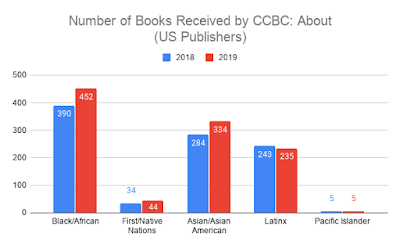Brief explanations of our numbers and charts are included in this post. For a more thorough explanation, please see the Diversity Statistics FAQ on our website.
For the first time this year, we are counting books by and about Pacific Islanders. Previously, these books were included in the Asian/Asian American count; we learned that that was not an accurate way to represent them. Thank you to Uyenthi Tran Myhre for correcting us. We retroactively examined the 2018 numbers in order to extract Pacific Islander numbers from Asian/Asian American numbers for comparison in this post.
Children’s Books By and/or About People of Color and from
First/Native Nations Received by the CCBC
2019
First/Native Nations Received by the CCBC
2019
US Publishers Only
Last updated: June 15, 2020
Year
|
Books
Received at CCBC |
Black / African
|
American Indian / First Nations
|
Asian /
Asian American |
Latinx
|
Pacific Islander
| |||||
By
|
About
|
By
|
About
|
By
|
About
|
By
|
About
|
By
|
About
| ||
2019
|
3,716
|
212
|
452
|
28
|
44
|
379
|
334
|
225
|
235
|
4
|
5
|
All Publishers
Last Updated: June 15, 2020
Year
|
Books
Received at CCBC |
Black / African
|
American Indian / First Nations
|
Asian /
Asian American |
Latinx
|
Pacific Islander
| |||||
By
|
About
|
By
|
About
|
By
|
About
|
By
|
About
|
By
|
About
| ||
2019
|
4,034
|
219
|
472
|
45
|
66
|
428
|
363
|
238
|
237
|
4
|
5
|
Please note that a single book may be counted in more than one category (e.g., one book may have two protagonists, one Black and one Native; a single author may identify as Afro-Latinx). Therefore, "by" and "about" numbers in the charts will not add up to the total number of books received. Likewise, percentages will not add up to 100.
The two charts below compare 2019 to 2018 "about" numbers (US publishers only). We count a book as "about" Black/African, for example, if a primary character, significant secondary character, subject, and/or setting is Black/African.
In the chart above, take a look at the first two bars on the left, labeled "Black/African." In 2018 (blue), we received 390 books that had significant Black/African content, including primary characters, significant secondary characters, subjects, and/or settings. In 2019 (red), we received 452 such books.
This may seem like a significant increase, but it actually represents just a 0.5% change. Since the total number of books we receive varies from year to year, it is helpful to consider percentages rather than raw numbers when comparing years.
Above, take a look at the two bars on the left, labeled "Black/African." In 2018 (blue), 11.7% of the total books we received were about Black/African characters, subjects, and/or settings. In 2019 (red), that number increased to 12.2%.
The above chart shows the number of books by--which means written and/or illustrated--at least one individual who identifies with the specified category. Take a look at the first two columns on the left, labeled "Black/African." In 2018 (blue), we received 193 books written and/or illustrated by at least one individual who is Black/of African descent. In 2019 (red), we received 212 such books.
The above chart shows the percentage of the total number of books we received. Take a look at the first two columns on the left, labeled "Black/African." In 2018 (blue), 5.8% of the total books we received were written and/or illustrated by at least one person who is Black/of African descent. In 2019 (red), that number dropped slightly to 5.7%.
Now let's take a closer look at primary characters (US publishers only). Below are the number of books that had at least one primary character who could be identified as belonging to one of the following categories.
Please note: These numbers are not the same as our "about" numbers. In addition to counting primary characters, our "about" numbers also include significant secondary characters, subjects, and/or settings. The numbers below are only primary characters.
Black/African: 441 (11.9% of total books)
First/Native Nations: 37 (1% of total books)
Asian/Asian American: 325 (8.7% of total books)
Latinx: 197 (5.3% of total books)
Pacific Islander: 2 (0.05% of total books)
Brown skin (see note below): 343 (9.2% of total books)
White: 1,555 (41.8% of total books)
LGBTQIAP+: 115 (3.1% of total books)
Disability: 126 (3.4% of total books)
Animal/Other: 1,085 (29.2% of total books)
Note: "Brown skin" indicates books in which the primary character clearly has brown skin (indicated by illustrations or text), but there are no specific racial or cultural signifiers in the illustrations or text.
For ease of comparison, here are the above percentages in a bar chart:
What does all of this mean? Our numbers continue to show what they have shown for the past 35 years: Despite slow progress, the number of books featuring BIPOC protagonists lags far behind the number of books with white main characters--or even those with animal or other characters. Taken together, books about white children, talking bears, trucks, monsters, potatoes, etc. represent nearly three quarters (71%) of children's and young adult books published in 2019.
Finally, as indicated by the addition of the Pacific Islander category in 2019, we are still learning as we do this work how best to do this work. We are grateful for the feedback and voices of Arab and Arab American colleagues on Twitter and elsewhere who have helped us understand the importance of adding Arab/Arab American as a category; this will be included and reflected in our statistics for 2020 and beyond.
Update: A previous version of this blog post used the term "(dis)ability." It has been corrected to "disability." Thank you to David Gillon for pointing out this error.






No comments:
Post a Comment